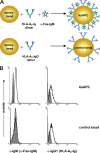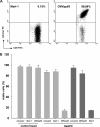Killer artificial antigen-presenting cells: a novel strategy to delete specific T cells
- PMID: 18096763
- PMCID: PMC2275020
- DOI: 10.1182/blood-2007-09-113522
Killer artificial antigen-presenting cells: a novel strategy to delete specific T cells
Abstract
Several cell-based immunotherapy strategies have been developed to specifically modulate T cell-mediated immune responses. These methods frequently rely on the utilization of tolerogenic cell-based antigen-presenting cells (APCs). However, APCs are highly sensitive to cytotoxic T-cell responses, thus limiting their therapeutic capacity. Here, we describe a novel bead-based approach to modulate T-cell responses in an antigen-specific fashion. We have generated killer artificial APCs (kappaaAPCs) by coupling an apoptosis-inducing alpha-Fas (CD95) IgM mAb together with HLA-A2 Ig molecules onto beads. These kappaaAPCs deplete targeted antigen-specific T cells in a Fas/Fas ligand (FasL)-dependent fashion. T-cell depletion in cocultures is rapidly initiated (30 minutes), dependent on the amount of kappaaAPCs and independent of activation-induced cell death (AICD). kappaaAPCs represent a novel technology that can control T cell-mediated immune responses, and therefore has potential for use in treatment of autoimmune diseases and allograft rejection.
Figures






Similar articles
-
Killer artificial antigen-presenting cells deplete alloantigen-specific T cells in a murine model of alloskin transplantation.Immunol Lett. 2011 Aug 30;138(2):144-55. doi: 10.1016/j.imlet.2011.04.002. Epub 2011 Apr 12. Immunol Lett. 2011. PMID: 21513739
-
Mature but not immature Fas ligand (CD95L)-transduced human monocyte-derived dendritic cells are protected from Fas-mediated apoptosis and can be used as killer APC.J Immunol. 2003 Jun 1;170(11):5406-13. doi: 10.4049/jimmunol.170.11.5406. J Immunol. 2003. PMID: 12759415
-
On the role and significance of Fas (Apo-1/CD95) ligand (FasL) expression in immune privileged tissues and cancer cells using multiple myeloma as a model.Leuk Lymphoma. 1998 Nov;31(5-6):477-90. doi: 10.3109/10428199809057607. Leuk Lymphoma. 1998. PMID: 9922038 Review.
-
Targeting antigen-specific T cells by genetically engineered antigen presenting cells. A strategy for specific immunotherapy of autoimmune disease.J Neuroimmunol. 2000 Jul 1;106(1-2):145-53. doi: 10.1016/s0165-5728(00)00201-0. J Neuroimmunol. 2000. PMID: 10814792
-
Nanoparticles for the Induction of Antigen-Specific Immunological Tolerance.Front Immunol. 2018 Feb 20;9:230. doi: 10.3389/fimmu.2018.00230. eCollection 2018. Front Immunol. 2018. PMID: 29515571 Free PMC article. Review.
Cited by
-
Cell and biomaterial delivery strategies to induce immune tolerance.Adv Drug Deliv Rev. 2023 Dec;203:115141. doi: 10.1016/j.addr.2023.115141. Epub 2023 Nov 18. Adv Drug Deliv Rev. 2023. PMID: 37980950 Free PMC article. Review.
-
Nanoengineering approaches to the design of artificial antigen-presenting cells.Nanomedicine (Lond). 2013 Jul;8(7):1173-89. doi: 10.2217/nnm.13.98. Nanomedicine (Lond). 2013. PMID: 23837856 Free PMC article. Review.
-
Polymeric micro- and nanoparticles for immune modulation.Biomater Sci. 2018 Dec 18;7(1):14-30. doi: 10.1039/c8bm01285g. Biomater Sci. 2018. PMID: 30418444 Free PMC article. Review.
-
Fas mediates cardiac allograft acceptance in mice with impaired T-cell-intrinsic NF-kappaB signaling.Transpl Int. 2009 Aug;22(8):845-52. doi: 10.1111/j.1432-2277.2009.00875.x. Epub 2009 Apr 1. Transpl Int. 2009. PMID: 19351347 Free PMC article.
-
On-target and direct modulation of alloreactive T cells by a nanoparticle carrying MHC alloantigen, regulatory molecules and CD47 in a murine model of alloskin transplantation.Drug Deliv. 2018 Nov;25(1):703-715. doi: 10.1080/10717544.2018.1447049. Drug Deliv. 2018. PMID: 29508634 Free PMC article.
References
-
- Toungouz M, Donckier V, Goldman M. Tolerance induction in clinical transplantation: the pending questions. Transplantation. 2003;75:58S–60S. - PubMed
-
- Lechler RI, Sykes M, Thomson AW, Turka LA. Organ transplantation: how much of the promise has been realized? Nat Med. 2005;11:605–613. - PubMed
-
- Anderson G, Moore NC, Owen JJ, Jenkinson EJ. Cellular interactions in thymocyte development. Annu Rev Immunol. 1996;14:73–99. - PubMed
-
- Krammer PH. CD95's deadly mission in the immune system. Nature. 2000;407:789–795. - PubMed
-
- Askenasy N, Yolcu ES, Yaniv I, Shirwan H. Induction of tolerance using Fas ligand: a double-edged immunomodulator. Blood. 2005;105:1396–1404. - PubMed
Publication types
MeSH terms
Substances
Grants and funding
LinkOut - more resources
Full Text Sources
Other Literature Sources
Research Materials
Miscellaneous

